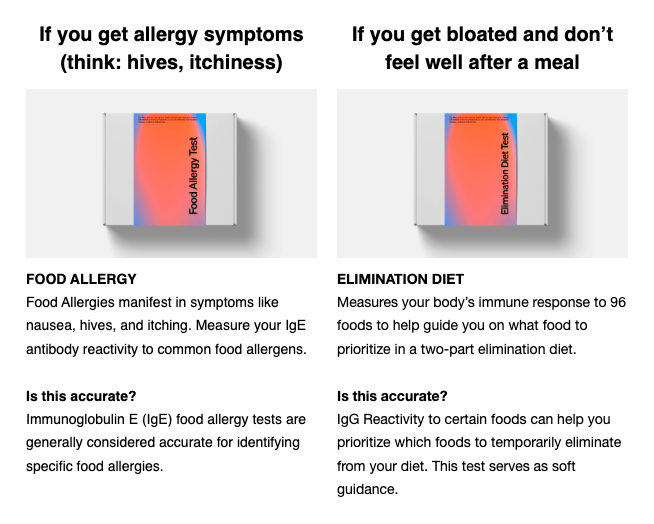Food sensitivities, intolerances, and allergies are common issues that can affect individuals of all ages, from children to adults. The impact of these reactions on daily life and overall well-being cannot be underestimated. In this comprehensive guide, we’ll take a closer look at each of these food reactions, exploring their prevalence, differences, and importance in identifying and understanding them for better health.
Food allergies, sensitivities, and intolerances affect a significant portion of the population. According to Food Allergy Research and Education (FARE), approximately 32 million Americans suffer from food allergies, a life-threatening immune response. Many others experience uncomfortable symptoms arising from food sensitivities and intolerances. These reactions can occur at any stage of life, with some people developing sensitivities later in life due to a weakening of the intestinal lining, leading to what is known as a “leaky gut.” Understanding these conditions is crucial for managing dietary choices and optimizing overall health.
While all three conditions involve adverse reactions to certain foods, they differ in their severity and underlying mechanisms. Food allergies, the most severe of the three, elicit an immediate and potent immune response. In contrast, food sensitivities lead to subtler, longer-lasting effects driven by different immune cells and responses. Food intolerances, mainly affecting the digestive system, may manifest with various symptoms and are often dose-related, allowing some tolerance to small amounts of the offending food.
Recognizing and understanding food allergies, sensitivities, and intolerances is essential for several reasons. Firstly, timely identification can prevent life-threatening allergic reactions and ensure appropriate medical intervention when necessary. Secondly, understanding the nuances of food sensitivities and intolerances empowers individuals to manage their diets effectively, reducing discomfort and improving overall quality of life. Proper management may involve dietary adjustments, avoidance of specific allergens, and working with healthcare professionals to create personalized strategies.
Want to check what foods don´t suit you?
Take the Base Elimination Diet Starter Test to get personalized recommendations and improvement plan based on your Foods Sensitivities & Allergies.
What’s the Difference between Food Allergies, Intolerances, and Sensitivities?
Food allergies trigger an immediate immune response as the body identifies certain foods as invaders. The immune system produces IgE antibodies that can lead to severe allergic reactions or anaphylaxis. This life-threatening condition can cause shock and requires immediate medical attention. Identifying common allergens and understanding the symptoms of food allergies is crucial for timely intervention and prevention.
Food sensitivities involve a different immune response compared to allergies. The body produces IgG antibodies, leading to more subtle and longer-lasting effects. While not typically life-threatening, food sensitivities can significantly impact daily life. Identifying trigger foods may require keeping a food diary and paying close attention to the body’s response after eating. Managing sensitivities may involve dietary modifications and addressing factors like stress and gut health.
Food intolerances mainly affect the digestive system and can cause discomfort, bloating, diarrhea, and other gastrointestinal symptoms. Unlike allergies and sensitivities, intolerances are often dose-related, allowing some tolerance to small amounts of the offending food. Identifying intolerances may involve elimination diets and careful observation of symptom patterns after food consumption.
By understanding the differences between food allergies, sensitivities, and intolerances, individuals can take proactive steps to manage their dietary choices, promote better digestive health, and optimize overall well-being. In the following sections, we will delve into specific symptoms, common allergens, diagnostic methods, and effective strategies for managing food reactions. Stay tuned for valuable insights and practical tips to help you navigate the complexities of food sensitivities, intolerances, and allergies.

Symptoms of Food Sensitivities, Intolerances, and Allergies
Common Symptoms of Food Sensitivities
- Abdominal Discomfort: Individuals with food sensitivities may experience a range of gastrointestinal symptoms, including bloating, gas, cramps, and general discomfort in the abdominal area. These symptoms often arise after consuming trigger foods and can persist for hours or even days.
- Fatigue and Brain Fog: One of the less obvious but significant symptoms of food sensitivities is persistent fatigue and difficulty with mental clarity, often referred to as “brain fog.” Individuals may feel constantly tired, sluggish, and have trouble concentrating after eating certain foods.
- Skin Issues and Joint Pain: Food sensitivities can also manifest as skin issues such as acne, eczema, or other rashes. Additionally, some people may experience joint pain or inflammation as a result of their body’s immune response to certain food components.
Recognizing Food Intolerances
- Digestive Symptoms like Bloating and Diarrhea: Food intolerances mainly affect the digestive system, leading to uncomfortable symptoms such as bloating, diarrhea, gas, and nausea. These reactions occur because the body lacks the necessary enzymes to fully digest certain components of the ingested food.
- Other Potential Manifestations: Food intolerances can have a broader impact beyond the digestive system. [Some individuals may experience headaches, migraines, constipation, mood disturbances}(https://www.ncbi.nlm.nih.gov/pmc/articles/PMC5007907/), or skin problems due to their intolerance to specific food components.
Identifying Food Allergies
- Skin Reactions, Vomiting, and Diarrhea: Food allergies typically trigger an immediate immune response, leading to skin reactions such as hives, itching, or redness. In more severe cases, individuals may experience vomiting and diarrhea shortly after consuming the allergenic food.
- Severe Symptoms and Anaphylaxis: Food allergies can cause anaphylaxis, a life-threatening allergic reaction that affects multiple body systems. Symptoms may include throat swelling, difficulty breathing, a sudden drop in blood pressure, and shock. Anaphylaxis requires immediate medical attention and the use of epinephrine to prevent potentially fatal outcomes.
Common Foods Causing Reactions
Foods Associated with Sensitivities and Intolerances
- Lactose, Gluten, Food Additives, and Caffeine: Lactose intolerance, gluten sensitivity, and reactions to food additives or caffeine are among the common examples of food sensitivities and intolerances. Lactose intolerance occurs when the body lacks sufficient lactase enzymes to digest lactose, leading to gastrointestinal symptoms.
- Alcohols, Eggs, Yeast, and Certain Fruits: Some individuals may experience adverse reactions to specific alcohols, eggs, yeast-containing foods, or certain fruits. These reactions can be identified through careful observation and elimination diets, which involve temporarily removing suspected trigger foods from the diet and reintroducing them one at a time.
Major Allergenic Foods
- Milk, Eggs, Peanuts, and Tree Nuts: Milk and eggs are common allergenic foods, especially in children. Peanut and tree nut allergies are also prevalent and can cause severe allergic reactions, making them a significant concern for individuals with allergies.
- Wheat, Soy, Fish, Shellfish, and Sesame: Wheat and soy allergies are common, and fish, shellfish, and sesame allergies can also trigger significant allergic responses. Allergic reactions to these foods can vary from mild skin irritations to severe anaphylaxis.
Being aware of the diverse symptoms associated with food sensitivities, intolerances, and allergies is crucial for timely recognition and appropriate management. Identifying the specific trigger foods can help individuals make informed dietary choices and lead to improved overall well-being and quality of life. In the next sections, we will explore various diagnostic methods and effective strategies for managing food reactions proactively and maintaining optimal health.
Diagnosing Food Sensitivities and Intolerances
The Role of Elimination Diets
Eliminating and Reintroducing Trigger Foods: Elimination diets are a fundamental approach to identifying food sensitivities and intolerances. Individuals remove potential trigger foods from their diet for a specific period, usually 2-4 weeks, to allow their system to reset. After this elimination phase, foods are gradually reintroduced one at a time to observe any adverse reactions. Keeping a detailed food diary during this process can help track symptoms and identify specific culprits.
Assistance from Health Coaches and Doctors: Navigating an elimination diet can be challenging without professional guidance. Health coaches and doctors can offer valuable support by creating personalized elimination plans, analyzing food diaries, and interpreting results. They play a crucial role in helping individuals uncover trigger foods and develop sustainable dietary changes for optimal health.
Laboratory Tests for Immune Responses
Food Sensitivity Tests and Their Limitations: While laboratory tests for food sensitivities exist, they have limitations. Food sensitivity tests can provide extensive lists of potential trigger foods, but the results may not always align with an individual’s real-life reactions. This discrepancy occurs because sensitivities can be influenced by various factors beyond immune responses, such as gut health and emotional stress.
Importance of Trial and Error to Find Specific Triggers: Due to the complexity of food sensitivities and intolerances, trial and error remain crucial in pinpointing specific triggers. The elimination diet remains the gold standard for identification, as it allows individuals to observe their body’s unique responses and make personalized dietary adjustments accordingly.

Addressing Food Reactions with Other Underlying Conditions
Considering Other Health Conditions like IBS and IBD
Individuals with food sensitivities, intolerances, and allergies may also have underlying gastrointestinal conditions such as Irritable Bowel Syndrome (IBS) or Inflammatory Bowel Disease (IBD). Addressing these conditions is essential for effective management. Differentiating between symptoms related to food reactions and those caused by other health issues can be challenging. Consulting healthcare professionals who specialize in gastrointestinal health can aid in accurate diagnosis and personalized treatment plans.
The Impact of Anxiety and Stress on Digestion
The connection between emotional well-being and digestive health should not be overlooked. Anxiety and stress can exacerbate digestive symptoms and trigger food sensitivities in some individuals. Adopting stress-reduction techniques such as mindfulness, meditation, or counseling can complement dietary changes in managing food reactions more effectively.
Supporting Gut Health and Restoring Gut Function
A healthy gut plays a pivotal role in mitigating food reactions. Supporting gut health through a balanced diet rich in fiber, probiotics, and prebiotics can promote a diverse gut microbiome, enhancing digestion and overall immune function. Additionally, gut-healing supplements and lifestyle adjustments like regular exercise and adequate sleep contribute to restoring gut function and reducing gastrointestinal distress.
Conclusion
Understanding the differences between food sensitivities, intolerances, and allergies empowers individuals to take proactive steps in managing their dietary choices and improving overall health. Identifying trigger foods, [seeking professional guidance](https://get-base.com, and making informed decisions can significantly enhance one’s quality of life.
Every individual’s body responds differently to food, making personalized approaches vital in managing food reactions effectively. Tailoring dietary adjustments based on individual needs and responses ensures a more targeted and sustainable strategy for long-term well-being.
Seeking professional support from health coaches and doctors is essential in navigating the complexities of food reactions. These experts can provide invaluable guidance, enabling individuals to uncover trigger foods and develop a personalized plan to optimize their digestive health.
By fostering awareness, seeking professional guidance, and prioritizing gut health, individuals can effectively manage food sensitivities, intolerances, and allergies, leading to a healthier and more enjoyable relationship with food.
Already have lab results from your annual physical?
Get a nutritional plan based on your labs results to improve weight management, energy and overall health